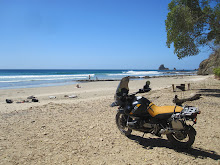The next day we got up early donned our gear, helmets and all before going outside to load the bikes. We took turns standing guard while holding my huge motorcycle lock and chain (a good theif deterrent) while the other packed and were able to take off without incident.
We rode fast through town again, following some directions we'd received the night before. We were happy to hit the huge cemetary full of sarcophagi which was the start of the highway out of town. Our destination was Dangriga, a costal town due south of Belize City, though we had to first jut inland for a while before heading towards the coast on what my map said was a 'Main Highway'. Turns out this 'Main Highway' was unpaved and mostly mud and potholes.
It was a beautiful ride, th,ough rough, through miles and miles of orange groves. Being that today was the 'day of thefts' we immersed ourselves in their culture and pilfered an armful of oranges which we'd stop and eat in the middle of the road during brief photo shoots.
The oranges down here are very different from what we get back in the States. They're natural. They have mottled green and brown skin and taste a little sweeter, like a tangelo; far better than the genetically modified, artificially colored stuff that Sunkist cranks out to please our judgmental eyes.
After a few hours we made it to Dangriga to the highly-recommended sea-side hostel, Vals. It was great spot where Vals daughter made us feel at home. The place was kinda lacking in color...it was entirely constructed out of unpainted concrete.
We were in need of a feed, specifically the famed rice n beans we'd been hearing about and rode around for half an hour and found nothing but ice cream shops and the occasional roadside eatery that didn't have rice n beans. We found it odd that it was so difficult to find the national food which seemed like it would be rather easy to make.
We asked some local guys if they had any idea where we could find some rice n beans and pointed us in various directions throughout the town. One guy gave us rough directions to some guys house that reportedly had food. We were told that he lived near the river, next to his mother and had great 'home made food'.
While trying to find this guy we came upon several large groups of people dancing in the street with a small group of women singing and a few guys banging on drums. There were about 25 men all dressed in women's clothing with Caucasian masks on. They arranged themselves in a circle from tallest to shortest, the littlest being maybe 3 years old. They would then take turns dancing in the center while the crowd cheered. We were never able to get a good answer as to what the dance was about, just a tradition they do around Christmas every year.
Post dance party we came across Elena, a lady of about 60 years on the side of the road with various pots and pans set on a table. We asked her if she had rice n beans, she did! She was happy to serve us our first rice n beans which we found out really refers to a BBQ-like meal. She served up a huge mound of maybe 70% rice and 30% smashed beans, half a chicken and some cole slaw. The chicken tasted like a good dry-rub Texas BBQ, excellent.
As we were chatting with Elena, a toddler came out from an upper balcony near us and started wailing and babbling while leaning through the rails.
"Quit your drop, bebey!" Elena snapped in an authoritative yet loving voice.
Da bebey shut up.
"Quit your drop....?" I said inquisitively.
"Yes, ma dear, it's Creole. Here we speak a mix of English, Spanish, Creole and Garifuna too."
She explained to us how Garifuna is both a language and culture, west African in nature. The Garifuna culture thrives mostly on the coast of Belize, Honduras and the nearby islands.
Just then two of Elena's other grandsons came over, maybe 10 years old and were talking amongst each other.
"Hey!" I yelled at them. "Quit your drop!" They both got wide eyed and Elena let out a howling laugh.
"Das good, das good!"
On the way home Luis crashed. He was ahead of me and was trying to pass a car on the right shoulder when he hit a stretch of mud. Upon trying to steer out of it the bike low-sided to the left and slid briefly, sending a spray of mud, rocks and vegetation into the air. Luis was able to get away from the bike early in the fall and escaped with just a bruised knee. The bike did fine too, just a few bent pieces here and there, nothing we couldn't kick back into place.
The next morning I got up early and went for a run. It was reportedly colder than anyone could remember, maybe in the 50s and the locals were heavily bundled up. It was still pretty comfortable by my standards so I took off my shirt before heading out through town.
I darted through alleys and down their main street then along a river leading to the sea then past a school where dozens of kids were milling around with backpacks almost as big as they were. Some of the kids would run up alongside of me then sprint ahead, frequently looking back and laughing.
Throughout the run I must have heard "Ain'tcha cold!?" ten times and just as many 'Gu Marnins!' My favorite though was some guy about my age who belted out, "You runnin from da cold, white boy!?"
We packed up and rode to the capitol city of Belmopan as I needed to pay a visit to the US Embassy. I had run out of pages in my passport and needed to get more added.
There was no doubt that the locals had nothing to do with the construction of the building. The doors were stainless steel, bomb and bullet resistant and hard to push open, there was no chipping plaster, leaning walls or strange smells. It felt kinda good being in this pseudo-USA. I had to strip down and run everything through a metal detector, all of which I was happy to do.
Being that I was in Latin America I expected this process to not go smoothly but it took just 45 minutes for them to put enough pages in my passport to last me a while. To have this same service down back home takes 3 days and $250, here it's free.
After leaving Belmopan we hit the Blue Hole and adjacent cave. There are actually two Blue Holes in Belize, one in a reef, one is a cenote in the jungle.
We first did our spelunking in what was the largest cave I've ever been in. At times our headlamps couldn't illuminate the walls around us as they were too far away. Our digital cameras could see farther than our eyes, though, so we'd frequently snap pictures, then review them to see what was out there.
We kept hearing rushing water but never saw it. We had the cave to ourselves and were able to hop around the strange formations before going to the cenote for a swim.
The cenote had tepid water, comfortable for swimming. A cenote is essentially a huge spring where water rises to the surface before flowing away on the surface. It was about 40 feet across and had a decent current rising out of the hole which then flowed sideways, forming a river.
The current was difficult to swim against, but upon reaching a sweet spot in the cenote we could feel the current pushing us up, providing a strange feeling of being more bouyant than usual.
After another brief ride (this country is really small) we made it to San Ignacio, adjacent to the Guatemalan border where we found another stand with rice n beans and a parrot that bit Luis. I also had the hottest food of my life here. They had a coarse salsa of sorts with pickled onions and habaneros which worked up quite a case of the sweats for me.
Tuesday, January 19, 2010
Subscribe to:
Post Comments (Atom)


So what does "Quit your drop" really mean? Sounds like you are having quite an adventure! - Brian W
ReplyDeleteTheir version of 'shut up'
ReplyDeleteMy brother is a federal agent with the US State Dept. He's worked at embassies and consulates all over the world and not only are they built by US contractors, all building materials are essentially escorted from the US to the destination country by State Dept personnel.
ReplyDelete